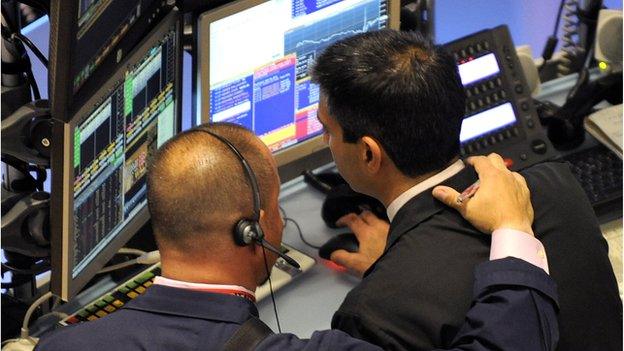Could one man cause a stockmarket crash?
- Published
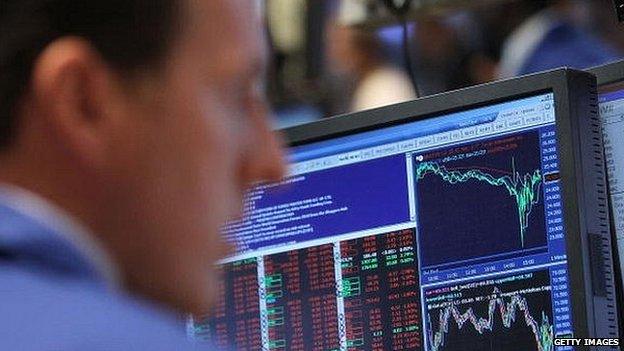
Billions were wiped off share values in minutes in May 2010
Exactly five years after the "flash crash" suddenly wiped nearly a trillion dollars from the markets, the US authorities are largely pointing at one man - a 36-year-old trader from Hounslow in west London.
But could one man really be responsible for the single biggest upheaval to trading in a decade?
Becoming a financial master of the universe, manipulating markets across the globe, wiping a trillion dollars off US stock markets and making yourself millions, may seem a tall order.
But according to allegations from no less an authority than the FBI, you don't have to travel to the City in a pinstripe suit at 6am and slick your hair back like Michael Douglas.
You can stay at home in your parents' suburban semi in Hounslow, even in your mid-thirties; wear a worn-out grey jogging top and bottoms; hang out in your bedroom and tinker on a computer.
You can get up at noon and crash out at 4am.
Get yourself a seat on the Chicago Mercantile Exchange - there's no need to travel to Chicago: it's all done remotely. Place bets on which way the S&P 500 index of shares in leading US companies is going to go - by trading contracts based on the future value of the index.
If you want the market to go down, place orders to sell stuff you don't actually own and never intend to sell. Your object is to influence the market - without actually trading.
Contracts change hands when the price at which they are offered is the cheapest on the market. To make sure your trades never go through, you make sure the price you offer to sell at is just a little bit above the cheapest price on the market.
Other traders, looking at the market's order book, see far more sell orders than buy orders. Fearing that the selling pressure will drag down the price, they sell - or their automated trading software does - and the price falls.
When it does so, you can make money, for example by placing a real order to buy.
Financial panic
According to the FBI's allegations, Navinder Singh Sarao, known as Nav to his friends and neighbours, did this on such a scale and to such lucrative effect that over four years he made $40m (£27m).
And humiliatingly for the regulatory authorities, the Chicago Futures Trading Commission in the US and the Financial Conduct Authority in the UK, he was allegedly able to evade any regulation and bat off regulators' inquiries for more than five years.
In late April 2010, Navinder Singh Sarao established a new company on the Caribbean island of Nevis, Nav Sarao Milking Markets Limited - though it had little to do with the dairy industry. The FBI claims it was part of a tax avoidance strategy.
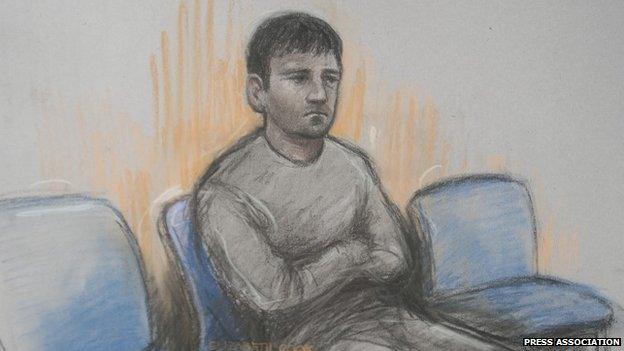
Mr Sarao has protested his innocence in court, saying he did not "do anything wrong"
On May 6 2010, exactly five years ago, argues the FBI, Mr Sarao used a computer programme or algorithm to create a huge number of sell orders between 11.17am and 1.40pm.
The FBI claims his sell orders were equivalent to the entire amount of "buy" orders placed by every other market participant. Minutes later came financial panic.
Between 1.41pm and 1.44pm the S&P plunged 3% then in just 15 seconds it dropped another 1.7%. Within minutes the S&P dropped 6%, far quicker than during previous crashes, before bouncing back up.
'Very bright, very diligent'
The above, however, is only the FBI's view. Beyond what has been said in court by his lawyers - that his arrest was a "bolt from the blue" - we still know very little of his side of the story.
Mr Sarao has been bailed on condition he places £5m as security. So far he hasn't come up with it. He is contesting the US attempt to extradite him.
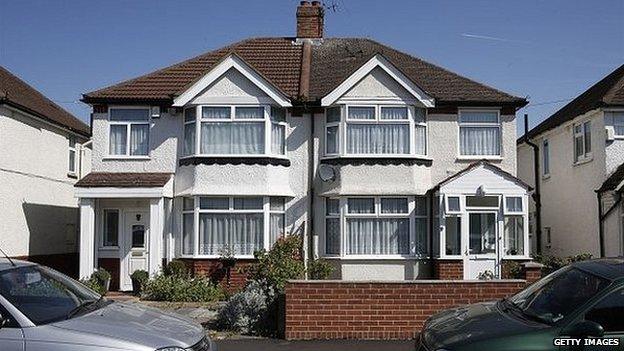
Mr Sarao operated from this semi-detached house in Hounslow, west London
Fellow traders find the FBI's allegations hard to believe. If his computer programme or algorithm was switched off at 1.40pm on May 6, how come the big falls on the market took place after that point?
Could just one man at home really cause such havoc in the markets?
Before setting up his own trading company at his parents' house, Mr Sarao graduated from Brunel University and worked for five years at the Woking offices of the commodities and futures traders, Futex.
Futex says there were no incidents of any impropriety during his time with the firm. It also says he never used an algorithm to trade, instead using old-style "point and click".
According to Futex boss Paulo Rossi, he was "very bright, very diligent, willing to take on risk - and he did take on risk." But he can't credit the idea that Mr Sarao could manipulate the whole Chicago futures market and cause an international financial panic.
"He was unusual in that he wasn't interested in money in order to spend the money. He was interested in purely focusing on growing his trading account," Mr Rossi told Bloomberg.
Bouts of illiquidity
Experts on the "flash crash" originally blamed the Kansas-based investment fund Waddell and Read, for trying to offload $4.1bn of futures contracts - a sell order so large it swamped the available buyers and allowed prices to go into free-fall.
Professor Maureen O'Hara at Cornell University, who was on the Flash Crash Commission that investigated the incident, resists the new alternative theory that blames it on one man.
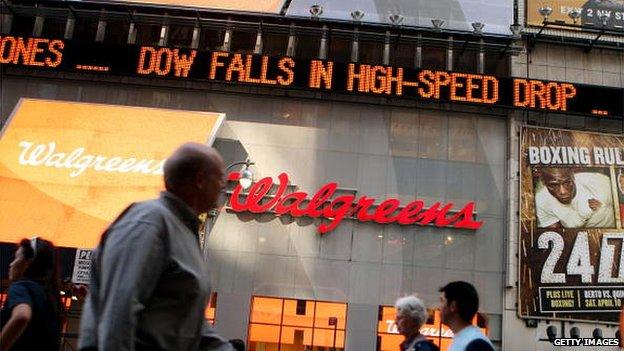
Could one man based in his bedroom in west London really cause the markets to crash?
"You can get a world where at the moment you have 100 sellers and you don't have 100 buyers. That price will fall off a cliff not because the underlying asset is worth less but because there is temporarily illiquidity.
"What you don't want to happen in a market is for prices to fall just because of that temporary imbalance."
She says that, far from being the work of one man, those temporary bouts of illiquidity are behind the flash crash of 2010 - and several "mini flash crashes" since.
You also get a different picture if you talk to people who know Mr Sarao. One boyhood companion and neighbour, Anil Puri, describes him as "a nice guy, fun to be with, sociable". But he's also surprised he could be accused of anything like manipulating markets in Chicago.
Another family friend, Rupinder Kesar told the BBC she was so shocked she hadn't been able to go to work the following day and was still trying to understand what has happened.
Automated trading
In fairness, the US authorities don't quite blame Mr Sarao alone for the flash crash, which briefly wiped a trillion dollars off US markets on 6 May. But they do allege he contributed to it, by creating a big imbalance in the market between buy and sell orders.
And they claim that on that one day he made $879,000 (£582,000). They also quote an email where Mr Sarao asserts that he made the majority of his money in just 20 days of trading.

With automated trading, prices can fall sharply if there are more sellers than buyers
If he behaved as the FBI alleges, then Mr Sarao may have evaded detection for years with embarrassing ease. The Chicago Mercantile Exchange told him on the day of the crash that "all orders…are expected to be entered into in good faith for the purpose of executing bona fide transactions".
After the crash he was allowed to continue trading. On 29 May 2014 he was asked about his sell orders and cancellations by the Financial Conduct Authority but told the regulator he was "an old school point-and-click prop trader". And he was still trading just a month ago.
The real importance of the FBI's allegations is less what they may say about Nav Sarao, and more what this says about how open to possible manipulation, in this age of automated trading software, the futures market has become.
- Published6 May 2015
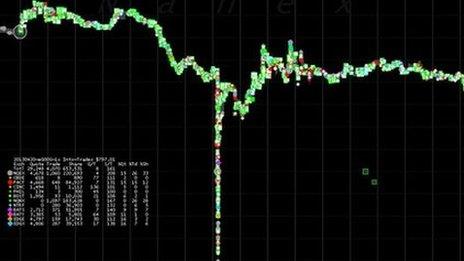
- Published29 April 2015

- Published22 April 2015

- Published22 April 2015
